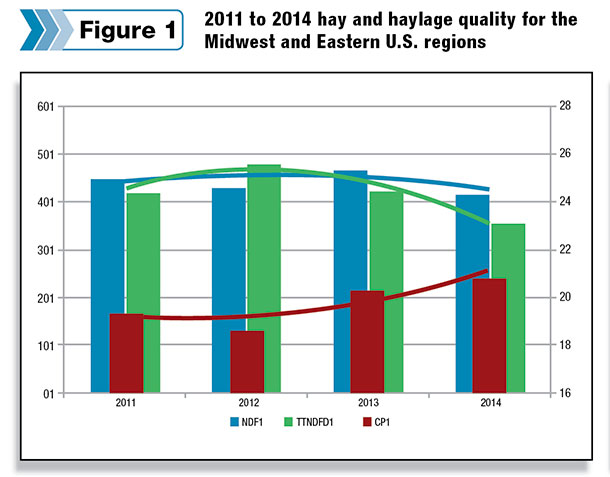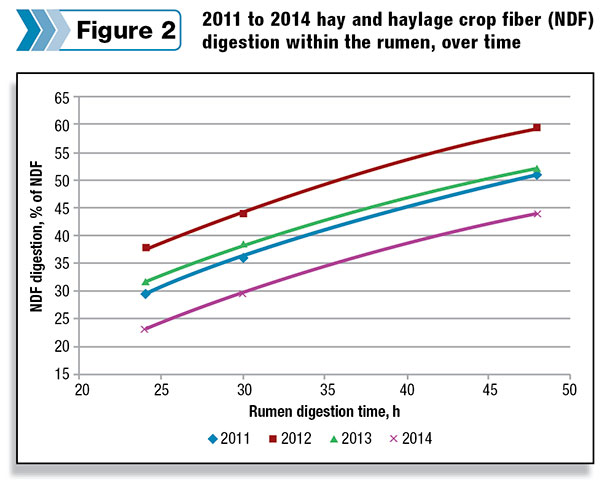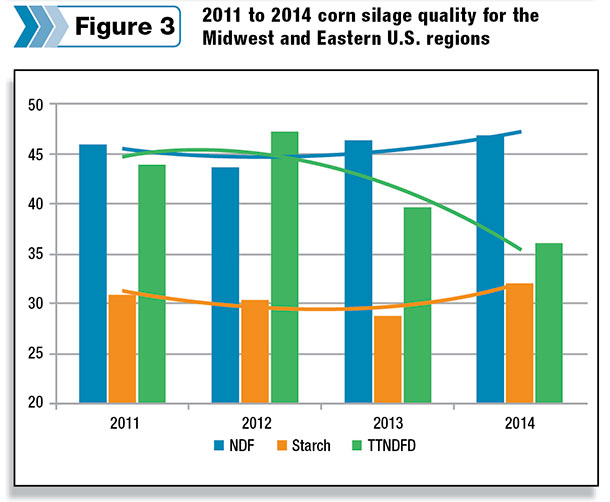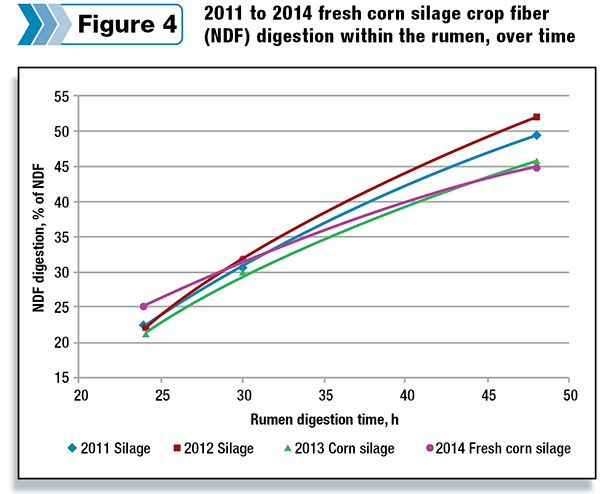It’s that time of the year. The leaves have colored and fallen, football season is in full swing, and we’re coming to grips with what kind of forage quality we have to feed deep into 2015. Hay and haylage crops are in storage and corn silage is being harvested throughout the Upper Midwest. While some were interested in my Halloween costume, more importantly and not jokingly, more people are asking about this year’s crop quality. How is our 2014 forage shaping up?
This year is a bit different than prior years. Take notice how I did not state that corn silage is finished. There are a substantial amount of silage acres yet to harvest, and variability seems unmatched this year. Despite silage details continually coming in, we do still have a fair indication of what’s in the silo this year for both hay crops and corn silages.
Earlier this year, I authored a management tip discussing hay and haylage quality that I was tracking through our Rock River Laboratory database. Figures 1 and 2 highlight the general outcome from the summer’s growing season: Hay and haylage quality on average are challenging across the Midwest and Northeast.


Protein levels increased and fiber (NDF) decreased, suggesting better crop nutritive value; however, fiber quality expressed as TTNDFD (total tract NDF digestibility, percent of NDF) continues a downward trend. The aim with TTNDFD is 48 percent or greater (Table 1), and you can see on average 2014 forage is well below the aim (Figure 1).

The TTNDFD is low because rumen fiber digestion is poor (Figure 2). The fiber is degraded slower and to less of an extent. Dairy cattle have agreed and many producers and nutritionists are asking how to improve performance given the challenged fiber potential.
While hay and haylage crops may present your dairy with challenges, unfortunately, corn silage does not appear capable of alleviating performance slumps based on what I’ve seen thus far.
Grain levels may be slightly greater this year, increasing starch yield (Figure 3), but NDF and TTNDFD look to be carrying over from the lower-quality 2013 silage we saw in many regions across the Midwest and eastern U.S.

Poor digestible fiber loads (more lignin) look to be dragging down fiber quality (Figure 4), and you can see by 48 hours in the rumen, fiber digestion has trailed off on average for 2014 corn silage. I’ll borrow an analogy and compare this year’s fiber potential to your car’s potential when having little gas in the tank: Neither gets us where we’d like to be.

Keep in mind variability is king this year; your crop may not fit the averages discussed here. Further and interestingly, fiber quality looks to differ by region.
Our TTNDFD in samples submitted to our lab in the Ohio region are numerically lower on average than the rest of the Midwest. Corn silages harvested in the West (mostly California) look substantially greater in quality than those in the Midwest and East.
This trend seems different from years past and may be related to drought stress, although this is purely speculation as I recognize that water availability and rights are at a premium. In following, irrigation may not be taking place as in the past.
While this year’s chapter of the never-ending forage story is nearly written, there is still some to learn as silage continues to be harvested across the northern U.S. Work with your consulting team to understand your forage quality and how it relates to your herd’s performance.
If you feel forage quality is limiting, consider replacing forage NDF with more digestible fiber (commodity feeds) or using research-proven additives to enhance fiber breakdown, increasing grain (while avoiding acidosis) or sugar levels, increasing metabolizable protein levels to cover for missing microbial protein or increasing energy density with high-quality fats. PD
John Goeser earned a Ph.D. in animal nutrition from the University of Wisconsin – Madison where he currently serves as an adjunct professor in the dairy science department. He also directs animal nutrition, research and innovation efforts at Rock River Lab Inc. based in Watertown, Wisconsin.
References omitted due to space but are available upon request. Click here to email an editor.

John Goeser
Director of Nutrition, Research and Innovation
Rock River Laboratory Inc.






